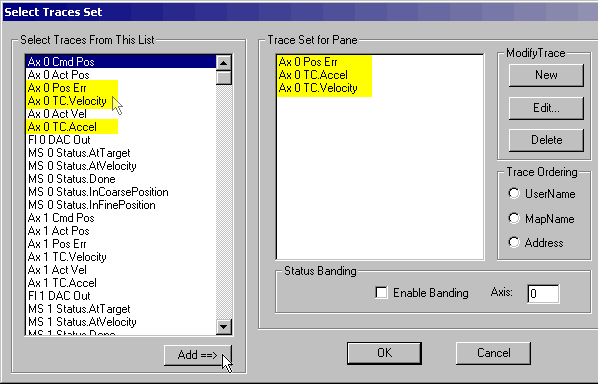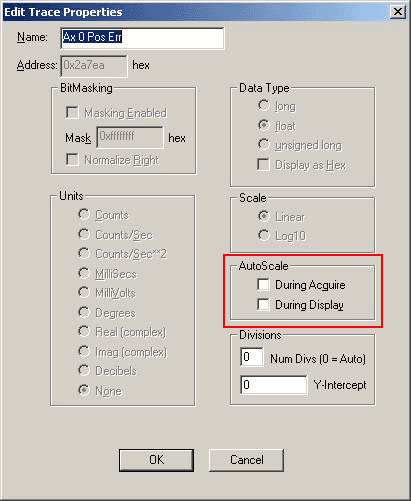
|
|
| . |
Shape-based Feedforward Tuning |
||||||||
You will need to tune the closed loop parameters (PID or PIV or etc.) before tuning the feedforwards. The closed loop tuning does not need to be perfect, but you will need to make several aggressive moves to optimize your feedforward coefficients.
Before attempting to turn the servo with Shape-based Feedforward Tuning, you will need to properly set up Motion Scope so that you can evaluate the motion with the appropriate data. You can easily designate which traces you wish to include on the motion plots by clicking the "Traces" button and selecting the following traces:
|

It is also important to read the changes in position
error from one trial to the next. In Motion Console, turn off auto scaling
on the position error trace by clearing the "During Acquire"
and "During Display" options under Traces ![]() Edit.
Edit.

A Trust TA 9000 will be used for the following examples, unless otherwise noted (www.trustautomation.com).
What is a good starting move?
Make a move that is representative of a large, quick move in your application.
As long as you are not clipping the DAC output or your drive, the faster
the move, the easier it will be to interpret the resulting plot.
Which feedforward term do I start with?
It doesn't matter which feedforward term you tune first. You will often
find that once you tune all the feedforward terms, you will want to readjust
one or two of the terms; this is normal. However, it can get complicated
with oscillations and systems that do not have a single dominant feedforward
term.
Here are the general rules:
- Add velocity feedforward if the position
error plot looks like the velocity plot.
- Add acceleration feedforward if it looks
like the acceleration plot.
- Add friction feedforward if it looks like
the sign of the velocity plot.
For all the shape-based tuning examples, the integral
will be set to zero (Ki = 0).
Ki = 0 because the integral will distort the shapes that we are looking
for. This does not mean that feedforwards will not work when the integral
is ON. It is just difficult to see the patterns when the integral is working
effectively, since it will try to reduce the position errors with time.
After you are done setting feedforwards, revert back to the original value
of Ki.
For more information about the different types of shape based tuning, please see the following sections:
| | | Copyright © 2001-2021 Motion Engineering |